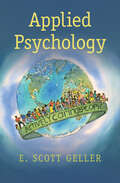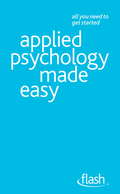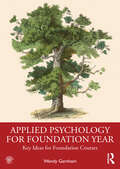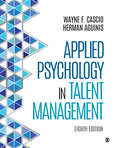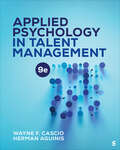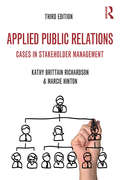- Table View
- List View
Applied Psychology
by E. Scott GellerThis volume demonstrates how readers can become more effective parents, teachers, students, coaches, managers, or work supervisors, while also gaining practical skills to enhance their self-motivation, communication skills, and intervention acumen. The first eight chapters explain evidence-based principles from applied behavioral science (ABS) that can be used to improve the human dynamics of any situation involving behavior. Fundamentals from humanism are integrated strategically to show how an ABS intervention can be more acceptable, influential, and sustainable. The following twelve chapters detail the deployment of ABS interventions to optimize performance in a wide variety of fields, including occupational and transportation safety, quantity and quality of organizational work behavior, healthcare, athletic coaching, parenting, pre-school and college education, environmental sustainability, and the control of obesity and alcohol abuse. Applied Psychology provides a thorough review of the latest research in relation to these domains and explores issues for future investigation.
Applied Psychology (BPS Textbooks in Psychology)
by Graham DaveyAPPLIED PSYCHOLOGY A practical and easy-to-understand introduction to applied psychology In the newly revised second edition of Applied Psychology, distinguished psychologist and author Graham Davey delivers an accessible introduction to the main areas of applied psychology from the perspectives of practitioners and researchers in the United Kingdom, Europe, and other parts of the world. It explains the core psychological knowledge and research that underpins the most commonly employed areas of applied psychology. This latest edition adds eight brand new chapters that cover emerging topics in applied psychology, and extensive revisions to all other applied psychology chapters. The book is accompanied by a resource website that offers a wide range of teaching and learning features, including a test bank, instructor slides, and a collection of professional and training chapters. Readers will also find: Thorough introductions to clinical, health, forensic, and educational psychology Comprehensive explorations of occupational, sport, and counselling psychology Practical discussions of coaching psychology, including the application of psychological theory during coaching Fulsome treatments of emerging topics in applied psychology, including environmental, consumer, community, and political psychology Perfect for Level 1 introductory psychology students, Applied Psychology will also benefit Level 2 and 3 students seeking core theoretical and professional information and be valuable for Masters students training for future practice.
Applied Psychology Made Easy: Flash
by Clive ErrickerWant to know about Applied Psychology but short of time and unsure where to begin? Get a kickstart with this little book which will give you just enough to get you going...
Applied Psychology Made Easy: Flash
by Clive ErrickerWant to know about Applied Psychology but short of time and unsure where to begin? Get a kickstart with this little book which will give you just enough to get you going...
Applied Psychology Practice in Professional Sport: Meeting the Person, Knowing the Athlete
by Mark NestiApplied Psychology Practice in Professional Sport is the first text to draw directly on psychological work delivered over many years to individual players and staff inside English Premier League Football as well as other professional sports, such as cricket, tennis, and golf.A key feature of this new text is the use of examples from the author’s applied practice, to demonstrate that many psychological terms and words used in the “lived world” of high-level professional sport, can be understood with greater depth and meaning where these are informed by more holistic perspectives such as existential, phenomenological, transpersonal and humanistic psychology. Implications for applied sport psychology practice are examined and recommendations offered.Although the book is about professional sport and psychology and is key readings for those associated within this discipline, the ideas and concepts discussed should be familiar to anyone involved in supporting people in challenging performance focused environments such as, business, education, or coaching professions. It is hoped that leaders, managers and other staff from these occupations, and closely related sectors, will find the book interesting and useful.
Applied Psychology Readings: Selected Papers From Singapore Conference On Applied Psychology 2016
by Man-Tak Leung Lee-Ming TanThis book is a compilation of the best papers presented at the 2017 edition of the Singapore Conference of Applied Psychology (SCAP), an event held annually in Singapore. Discussing the latest innovations, trends, concerns, practical challenges encountered and the solutions adopted in the field of applied psychology, it is a valuable resource for academics, researchers and practitioners wishing to keep themselves up to date with the state of the art in the field.
Applied Psychology Readings: Selected Papers from Singapore Conference on Applied Psychology, 2016
by Man-Tak Leung Lee-Ming TanThis book features the best papers presented at the Singapore Conference on Applied Psychology in 2016. Chapters include research conducted by experts in the field of applied psychology from the Asia-Pacific region, and cover areas such as community and environmental psychology, psychotherapy and counseling, health, child and school psychology, and gender studies. Put together by East Asia Research (Singapore), in collaboration with Hong Kong Shue Yan University, this book serves as a valuable resource for readers wanting to access to the latest research in the field of applied psychology with a focus on Asia-Pacific.
Applied Psychology Readings: Selected Papers from the Singapore Conference on Applied Psychology 2021
by Lee Ming Tan Thomas HuntThis book is a compilation of the best papers presented at the 2021 edition of the Singapore Conference of Applied Psychology (SCAP) organised and facilitated by East Asia Research in Singapore. The selection of papers addresses the latest innovations, trends, concerns and practical challenges encountered in the field, and poses practical solutions within the field of applied psychology. The theme for 2021 is psychological well-being, and so the collection covers aspects of clinical and non-clinical psychological well-being in different arenas, from education to the workplace. Following a rigorous peer-review process led by the School of Psychology at the University of Derby, this collection is a valuable resource for academics, researchers and practitioners looking to keep themselves up-to-date with recent research in the field. The book is of interest to educators and practitioners in applied psychology focused on well-being.
Applied Psychology Readings: Selected Papers from the Singapore Conference on Applied Psychology 2022
by Lee-Ming Tan Peter MacaulayThis book is a compilation of the best papers presented at the 2022 edition of the Singapore Conference of Applied Psychology (SCAP), led by East Asia Research in Singapore in collaboration with the University of Derby in the UK and the Singapore University of Technology and Design. Chapters include research conducted by experts in the field of applied psychology from the Asia-Pacific region, and cover areas such as community and environmental psychology, psychotherapy and counseling, health, child and school psychology, and gender studies. The volume is of interest to educators, psychology researchers and practicing counselors.
Applied Psychology Readings: Selected Papers from the Singapore Conference on Applied Psychology 2023 (Springer Proceedings in Behavioral & Health Sciences)
by Brian Moore Lee-Ming Tan Elizabeth Murray Matthew WinsladeThis book is a compilation of the best papers presented at the 2023 edition of the Singapore Conference of Applied Psychology (SCAP), led by East Asia Research in Singapore in collaboration with the Singapore University of Technology and Design and Charles Sturt University in Australia. Chapters include research conducted by experts in the field of applied psychology from the Asia-Pacific region, and cover areas such as the latest innovations, trends, concerns, practical challenges encountered and the solutions adopted in the field of applied psychology such as community and environmental psychology, psychotherapy and counseling, health, child and school psychology, and gender studies. The volume will be of interest to educators, psychology researchers and practicing counselors.
Applied Psychology for Foundation Year: Key Ideas for Foundation Courses
by Wendy GarnhamApplied Psychology for Foundation Year: Key Ideas for Foundation Courses introduces students to topical issues and controversies within specific areas of applied psychology, bringing together current theories and studies from a number of areas within applied psychology through a series of interesting and current debates and controversies. Included in this book are a series of snapshots of how psychologists have tried to apply their findings to real-life problems. Using a clear structure and accessible tone, this book demonstrates how psychological research can be applied to inform current debates across a variety of the field’s subdisciplines. Through examination of both established theoretical ideas and more recent empirical evidence, it enables readers to see how research is linked to practical application in occupational psychology, educational psychology, criminology, sport psychology and environmental psychology. In doing so, it explicates contemporary theories and studies and contributes a cross-cultural understanding of these topics. This book’s wide coverage of topics and theories is designed to enable readers to not only immerse themselves in topical and often controversial debates but also to develop a critical awareness of alternative viewpoints, methodological weaknesses and theoretical shortcomings. Readers are encouraged to consider and question these theories and consider the implications of this research and how the findings can be applied to their own experience. Applied Psychology for Foundation Year is a key textbook for both foundation year and introductory psychology courses and will be of interest to anyone wanting to delve into topical issues in contemporary psychology.
Applied Psychology for Project Managers: A Practitioner's Guide to Successful Project Management (Management for Professionals)
by Michael A. West Monika Wastian Isabell Braumandl Lutz RosenstielThis book offers an essential manual for project managers, project management offices (PMO's), trainers and consultants, addressing the psychological side of project management. Written by leading scholars in organizational psychology and by top experts in project management, it covers all major psychological topics that are key to project success. The book features dedicated chapters on leadership and teamwork, including virtual and intercultural cooperation, commitment and motivation of project teams. It adds a psychological perspective to personnel management, decision-making, information and knowledge management and communication in project work. Power, influencing tactics and other aspects of stakeholder management are covered, as well as project coaching, innovation and creativity, self-management and the management of conflicts, risks and crises.
Applied Psychology for Social Work (Transforming Social Work Practice Series)
by Ewan InglebyPsychology is an important part of the social work syllabus, usually studied as a separate module in the first year, but also integrated within the academic curriculum. This fully updated edition will help students understand the concepts of psychology and apply them to their own practice. It shows that, for social workers, it is important for psychology to be studied in the contexts of social care, as it offers potential explanations of complex aspects of human behaviour and development. An overview of the key psychological approaches is given and the author demonstrates how these can be applied to social work practice.
Applied Psychology in Talent Management
by Herman Aguinis Professor Wayne F. CascioIn Applied Psychology in Talent Management, world-renowned authors Wayne F. Cascio and Herman Aguinis provide the most comprehensive, future-oriented overview of psychological theories and how they impact people decisions in today’s ever-changing workplace. Taking a rigorous, evidence-based approach, the new Eighth Edition includes more than 1,000 new citations from over 20 top-tier journal articles. The authors uniquely emphasize the latest developments in the field—all in the context of historical perspectives. Integrated coverage of technology, strategy, globalization, and social responsibility throughout the text provides students with a holistic view of the field and equips them with the practical tools necessary to create productive, enjoyable work environments.
Applied Psychology in Talent Management
by Herman Aguinis Professor Wayne F. CascioIn Applied Psychology in Talent Management, world-renowned authors Wayne F. Cascio and Herman Aguinis provide the most comprehensive, future-oriented overview of psychological theories and how they impact people decisions in today’s ever-changing workplace. Taking a rigorous, evidence-based approach, the new Eighth Edition includes more than 1,000 new citations from over 20 top-tier journal articles. The authors uniquely emphasize the latest developments in the field—all in the context of historical perspectives. Integrated coverage of technology, strategy, globalization, and social responsibility throughout the text provides students with a holistic view of the field and equips them with the practical tools necessary to create productive, enjoyable work environments.
Applied Psychology in Talent Management
by Wayne F. Cascio Herman AguinisIn the Ninth Edition of Applied Psychology in Talent Management, world-renown authors Wayne F. Cascio and Herman Aguinis provide the most comprehensive, future-oriented overview of psychological theories and how they impact people decisions in today′s workplace. Taking a rigorous, evidence-based approach, the new edition includes more than 750 new citations from top-tier journal articles. Integrated coverage of technology, strategy, globalization, and social responsibility throughout the text provides students with a holistic view of the field and equips them with the tools necessary to create productive, enjoyable work environments.
Applied Psychology in Talent Management
by Wayne F. Cascio Herman AguinisIn the Ninth Edition of Applied Psychology in Talent Management, world-renown authors Wayne F. Cascio and Herman Aguinis provide the most comprehensive, future-oriented overview of psychological theories and how they impact people decisions in today′s workplace. Taking a rigorous, evidence-based approach, the new edition includes more than 750 new citations from top-tier journal articles. Integrated coverage of technology, strategy, globalization, and social responsibility throughout the text provides students with a holistic view of the field and equips them with the tools necessary to create productive, enjoyable work environments.
Applied Psychology in the Modern Era: Integrating Theory, Research, and Practice for Real-World Application
by Jason Walker Deborah CircoThis book provides an in-depth examination of the application of applied psychology within and contemporary context offering readers critical insights into understanding human behaviour. The authors are scholars and practitioners in specialized areas delivering cutting-edge research and perspectives on various topics related to applied psychology. The core topics reflect the diversity of human behaviour and specialty fields in psychology that explore and examine the deeper meaning of how psychology impacts daily life. This includes specialty areas such as clinical and counselling psychology, education, health, sport, leadership, and industrial-organizational psychology. In addition, each chapter offers an in-depth analysis of the subject matter, providing readers with the general skills and knowledge to understand psychology in practical settings. Through the application of best practices and the integration of theory, research and applied practice issues, this book creates space for acomprehensive examination of the field of applied psychology. Drawing on contemporary real-world issues, this book is a must-read resource for students, educators and practitioners who are seeking to practice in the field of psychology. Examining key issues through a modern world context, " Applied Psychology in the Modern Era: Integrating Theory, Research, and Practice for Real-World Application," focuses on issue of diversity, inclusion, and equity. By examining the impact of gender, LGBTQAI+ and vulnerable populations, the authors provide a unique understanding of how cultural, social factors impact human behaviours.
Applied Psychology: New Frontiers and Rewarding Careers (Applied Psychology Ser.)
by Stewart I. Donaldson Dale E. Berger Kathy PezdekApplied Psychology demonstrates the power of applied psychology to promote human welfare and optimal human functioning as well as the vast career opportunities that exist for those with a psychology education. Some of the most eminent psychologists in the world today examine how psychological science is and can be used to prevent and ameliorate pressing human problems to promote positive social change. Part one provides an overview of the history and rise of applied psychology. The second part provides examples of how psychological science has been, and can be used, to prevent and ameliorate human problems. Part three presents examples of cutting-edge research in applied psychology, while exploring non-traditional career opportunities. The contributors provide evidence for the range of career opportunities, discuss skill and educational requirements, and explore the quality of work life in a wide range of areas within psychology. Advice on what it takes to prepare for a rewarding career in applied psychology is also provided.Intended as a supplement for courses in introductory or applied psychology, contemporary issues, professional development, social and organizational psychology, this book will also be a valued addition to campus career centers. Psychologists considering new career options will also appreciate this volume.
Applied Psychology: Research, Training and Practice (Practical Social Work Series)
by Gordon Jinks Rowan BayneIn this revised new edition, Bayne and Jinks expertly combine the professional and academic aspects of applied psychology. The contributing authors, all experts in their field, provide authoritative and engaging overviews of their areas of expertise and an important range of perspectives. The book is organised into three parts. The first part is a general context for applied psychology including a discussion of questions about evidence based practice. The second part discusses practice and training in a plethora of areas of applied psychology, including all of the traditional routes (for e.g. clinical, health and educational psychology), eight ′relative newcomers′ to the field (for e.g. sport and forensic psychology) and four areas not always regarded as applied psychology: counselling, coaching, careers guidance and lecturing. The innovative third part is a roundtable of expert practitioners commenting on the new directions they would like to see in their areas of applied psychology. Applied Psychology: Research, Training and Practice 2nd Edition will be essential for all students considering a career in an applied field, either those studying applied psychology at undergraduate level or MSc students on applied psychology courses at this level.
Applied Psychometry (SAGE Texts)
by Narender Kumar ChadhaApplied Psychometry is a core textbook on the theory and practice of psychometry for undergraduate, post-graduate, and research students of Behavioural and Social Sciences. It is designed to help students in their study of the following papers: •B.A. Programme Psychology (Core): Psychological Assessment. •B.A. Honours Psychology (Core): Research Method and Psychological Testing. •M.A. Psychology: Research Methodology. •PhD: Quantitative Methods. •B.Ed / M.Ed./ B.P.Ed/ M.P.Ed/ MHROD/MBA(HR). This textbook is also a valuable reference material for practising human resource managers. Applied Psychometry is unique in that it serves a dual purpose. While discussing various aspects of psychometry from an applied perspective, it also takes into account the matching theoretical orientation. The important features of the book include: •Current issues and debates and their implications on the theory and practice of psychometry. •An active teaching–learning interface with many examples and activities. •Chapters on multivariate techniques like factor analysis, its applications and real data treatment. •Construction and standardisation of scales and tests for measurement. •An Instructor′s Manual to facilitate its use and effectiveness in an institutional set-up. This book discusses the application of psychometry in educational, organisational, clinical and developmental settings, among others. It equips its readers with the knowledge of the latest developments in the field and offers guiding solutions to a set of selected research problems.
Applied Public Relations: Cases in Stakeholder Management (Routledge Communication Series)
by Kathy Brittain Richardson Marcie HintonWith its practical orientation and scope, Applied Public Relations is the ideal text for any public relations case studies or public relations management course that places an emphasis on stakeholder groups. Through the presentation of current cases covering a wide variety of industries, locations, and settings, Kathy Richardson and Marcie Hinton examine how real organizations develop and maintain their relationships, offering valuable insights into business and organizational management practices. The book’s organization of case studies allows instructors to use the text in several ways: instructors can focus on specific stakeholders by using the chapters presented; they can focus on particular issues, such as labor relations or crisis management by selecting cases from within several chapters; or they can select cases that contrast campaigns with ongoing programs or managerial behaviors. A focus on ethics and social responsibility underlies the book, and students are challenged to assess the effectiveness of the practices outlined and understand the ethical implications of those choices. This Third Edition features: 25 new and current domestic and international case studies specifically chosen for their relevancy and relatability to students New "Professional Insights" commentaries where practitioners respond to a set of questions relating to their work Increased emphasis on ethics and social responsibility Fully enhanced companion website that is connected with the text, including a test bank and PowerPoint presentations for instructors, and chapter-specific discussion questions and additional readings for students
Applied Qualitative Research Design
by Paul J. Lavrakas Margaret R. RollerThis unique text provides a comprehensive framework for creating, managing, and interpreting qualitative research studies that yield valid and useful information. Examples of studies from a wide range of disciplines illustrate the strengths, limitations, and applications of the primary qualitative methods: in-depth interviews, focus group discussions, ethnography, content analysis, and case study and narrative research. Following a consistent format, chapters show students and researchers how to implement each method within a paradigm-neutral and flexible Total Quality Framework (TQF) comprising four interrelated components: Credibility, Analyzability, Transparency, and Usefulness. Unlike other texts that relegate quality issues to one or two chapters, detailed discussions of such crucial topics as construct validity, interresearcher reliability, researcher bias, and verification strategies are featured throughout. The book also addresses applications of the TQF to the writing, review, and evaluation of qualitative research proposals and manuscripts. Pedagogical Features: *Summary tables that highlight important content, such as the application of a method to vulnerable or hard-to-reach populations. *Case studies that illustrate TQF standards in practice for each method. *Guidelines for effective documentation (via thick descriptions) of each type of study. *End-of-chapter discussion topics, exercises, and suggested further reading and Web resources. *Chapters open with a preview and close with a bulleted summary of key ideas. *Extensive glossary.
Applied Quantitative Analysis for Real Estate
by Sotiris Tsolacos Mark AndrewTo fully function in today’s global real estate industry, students and professionals increasingly need to understand how to implement essential and cutting-edge quantitative techniques. This book presents an easy-to-read guide to applying quantitative analysis in real estate aimed at non-cognate undergraduate and masters students, and meets the requirements of modern professional practice. Through case studies and examples illustrating applications using data sourced from dedicated real estate information providers and major firms in the industry, the book provides an introduction to the foundations underlying statistical data analysis, common data manipulations and understanding descriptive statistics, before gradually building up to more advanced quantitative analysis, modelling and forecasting of real estate markets. Our examples and case studies within the chapters have been specifically compiled for this book and explicitly designed to help the reader acquire a better understanding of the quantitative methods addressed in each chapter. Our objective is to equip readers with the skills needed to confidently carry out their own quantitative analysis and be able to interpret empirical results from academic work and practitioner studies in the field of real estate and in other asset classes. Both undergraduate and masters level students, as well as real estate analysts in the professions, will find this book to be essential reading.
Applied Quantitative Analysis in Education and the Social Sciences
by Christopher Schatschneider Yaacov Petscher Donald L. ComptonTo say that complex data analyses are ubiquitous in the education and social sciences might be an understatement. Funding agencies and peer-review journals alike require that researchers use the most appropriate models and methods for explaining phenomena. Univariate and multivariate data structures often require the application of more rigorous methods than basic correlational or analysis of variance models. Additionally, though a vast set of resources may exist on how to run analysis, difficulties may be encountered when explicit direction is not provided as to how one should run a model and interpret results. The mission of this book is to expose the reader to advanced quantitative methods as it pertains to individual level analysis, multilevel analysis, item-level analysis, and covariance structure analysis. Each chapter is self-contained and follows a common format so that readers can run the analysis and correctly interpret the output for reporting.
